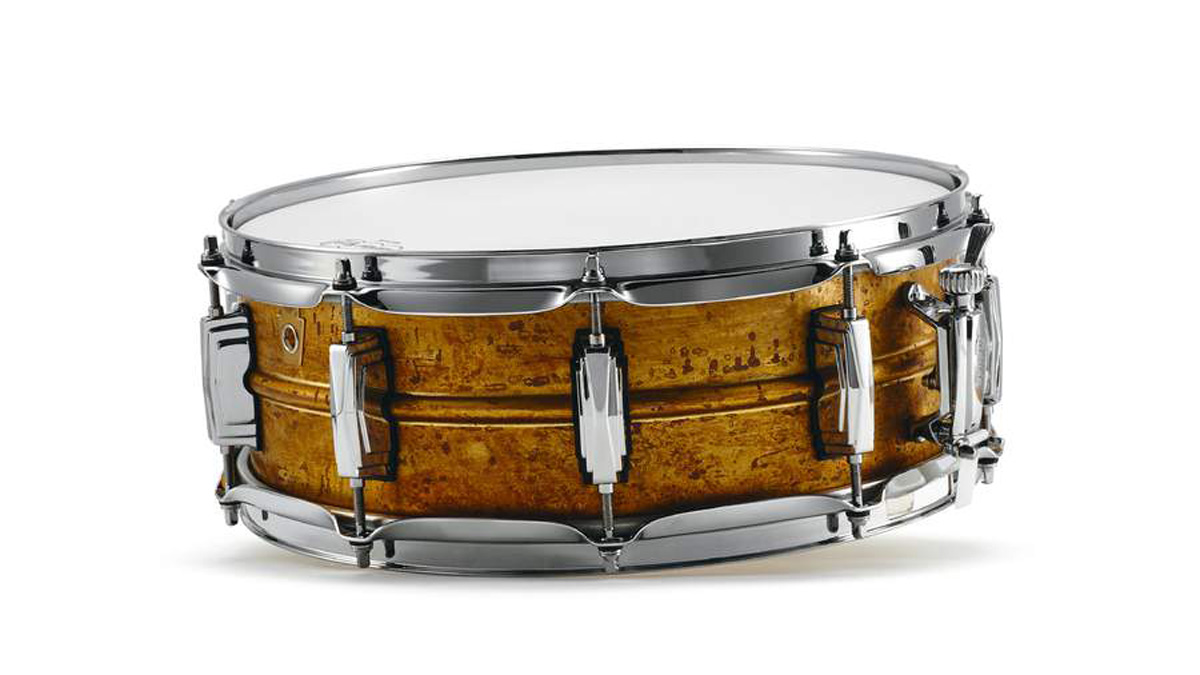MusicRadar Verdict
Once again Ludwig scores with two contrasting but equally tempting snares. The Raw Brass is expensive but highly musical, the Standard Maple a modern eco-friendly workhorse.
Pros
- +
Wonderfully well-made.
Cons
- -
Very few.
MusicRadar's got your back
Ludwig’s Supraphonic is probably the most famous and long-running snare drum of all time.
Now in recent years, Ludwig has justifiably taken to extending the formula by offering variations on the basic aluminium Supraphonic with the Bronze Phonic and Copperphonic. And following the release of 2016’s Raw Patina Copperphonic, Ludwig adds this funky-looking Raw Brass Phonic. Alongside this we have the 2018 edition of what Ludwig calls its Standard Maple snare drum, which was first seen in 2017.
Build
Ludwig fans will be aware that the earliest (1960s) Supraphonics had brass shells before the aluminium version became massively popular. A brass shelled Supra with a black nickel exterior is a Black Beauty, which is Ludwig’s other legendary all-time winner. So we can view this Raw Brass version as basically a Black Beauty minus the black finish.
The raw brass shell itself is 1.2mm gauge and seamless - the crucial asset of Ludwig’s expensive American-sourced metal shells. Ludwig USA’s Uli Salazar tells us that the ‘raw’ finish is, “natural oil and lubricant remnants from the shell formation. We don’t treat the shells to age them. They simply come out that way and we spray a very light sealer coat on them”.
So, as with the Raw Patina Copperphonic every drum is visually unique. The variegated brass is offset by the gleaming chrome of the 2.3mm triple-flanged steel hoops and 10 Imperial lugs. It’s certainly an arresting image.
While the Raw Brass extends a classic formula, the Standard Maple shows Ludwig moving with the times, offering a 5-ply, 5mm American maple shell (Ludwig’s Classic Maple snares are 7-ply) with a synthetic Eco-Tech outer veneer. The latter is an increasingly popular alternative to scarce exotic wood veneers, much like Sonor’s SQ2 and other companies’ ALPI finishes. Ludwig used it first on the 2014 Signet series. It’s described as a ‘durable outer veneer’, although you would not mistake it for a real veneer.

And indeed the review drum finish is called Brandy, so Ludwig is not trying to pull a fast one! The point is, as Uli Salazar explains: “They are digitally created to save on the use of exotic trees. They offer extraordinary durability compared to a true veneer, and are great value as well.”
We have the 14"x8" model, there’s a 6½" too, and both have 10 Classic ‘bowtie’ lugs. Centrally mounted, these Classic lugs necessitate over-long tension rods, which always looks a bit unwieldy.
Both drums have the relatively new P88AC (Atlas Cast) strainer, the long-awaited and most welcome smooth-action replacement for the ancient P85. The Raw Brass has a cast P35 butt plate as well, while the Standard Maple has a P32, a type Ludwig has been using for way over a half-century. It’s basic and you’ll need a screwdriver to tighten it, but it does the job.
Hands on
With its 1.2mm gauge metal and 2.3mm triple-flanged hoops, the Raw Brass Phonic is heavy - rather heavier than a regular aluminium Supraphonic. It feels substantial, and you are immediately reassured by the sound, which is tonally rich. In fact, it sounds the way it looks - a lethal combination of super-clean bright and shiny chrome with musically complex and dusky funky brass.
Brass has a dark timbre, more colourfully complex than aluminium. We put this drum next to an old Supraphonic and it is deeper pitched while remaining sharp and crisp. By today’s standards the Imperial lugs are chunky but they don’t seem to affect resonance unduly other than maybe contributing to the focused compactness of the sound. Ludwig also makes snares with tube lugs, which no doubt are less constricting, but the Imperials have never been an issue.
A lethal combination of super-clean bright and shiny chrome with musically complex and dark funky brass
The Standard Maple has a thin 5mm, 5-ply shell. We have been sent the 14"x8" model to review, and here’s something interesting about it. Playing this next to the brass Supra, sitting above the drums as normal, it strikes me that the maple drum actually seems brighter than the brass. The brass is sharp, metallic, clangy – but the maple has an inherent perkiness that appears initially to produce a higher register ping, even though the shell is 8" deep. Applying batter head damping, those high perimeter frequencies are subdued and now you start to appreciate the extra body of the maple drum.
We get a friend to play both drums while we walk away and we really hear the difference. The depth, volume and rounded woodiness of the deep 8" drum becomes increasingly dominant. But the brass drum has a presence and a rich musicality, which is why brass snares are so loved by many drummers.
“Built from the same sacred stash of NOS silicon transistors and germanium diodes, giving it the soul – and snarl – of the original”: An octave-fuzz cult classic returns as Jam Pedals resurrects the Octaurus
What’s the buzz? Meet Yellowjacket, Cherry Audio's recreation of EDP’s trend-setting Wasp from 1978
“A fabulous trip through all eight songs by 24 wonderful artists and remixers... way beyond anything I could have hoped for”: Robert Smith announces new Cure remix album










